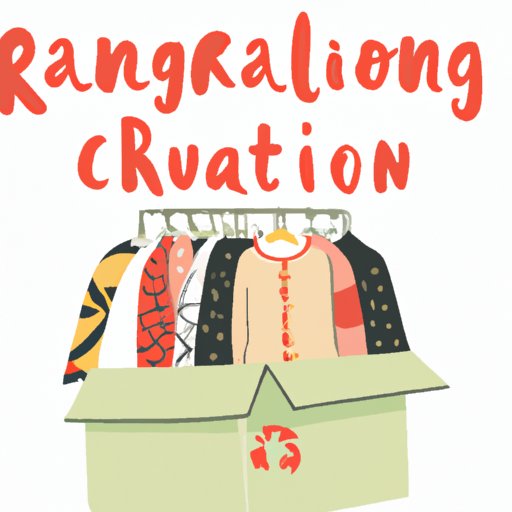Introduction
Clothing recycling is the process of taking unwanted or used clothes and reusing them in some way, either through donation or upcycling into new garments. With the growing awareness of the environmental impact of the fashion industry, more people are looking for ways to reduce their own contribution to textile waste. Recycling clothes is one way to do this, as it not only helps to reduce the amount of clothes that end up in landfills, but can also help you create a more sustainable wardrobe.

How to Donate Clothing for Recycling
Donating clothing for recycling is one of the easiest and most effective ways to reduce textile waste. There are many organisations that accept donations of clothing, from charity shops to specialised clothing recycling companies. It’s important to check what types of clothing each organisation accepts before donating, as not all organisations will take the same items.
Most organisations will accept any type of clothing, including shoes, accessories and even linens. However, there are some items that cannot be accepted, such as underwear and socks. It’s also important to check if the organisation requires the clothes to be in good condition, as some may only accept items that are still wearable. If the clothing is not in good enough condition to be donated, it should be disposed of responsibly.

How to Upcycle Clothing into New Pieces
Upcycling is the process of taking an old piece of clothing and transforming it into something new. This can be done by refashioning the item into a completely different garment, or simply by adding a few touches to give it a new look. There are plenty of tutorials online that can help you get started with upcycling, from sewing basics to more advanced techniques. You can also find inspiration for new looks on social media or in magazines.
When upcycling clothes, it’s important to consider the fabrics you’re working with. Different fabrics require different kinds of care and attention when being refashioned, so it’s always best to research the fabric before starting a project. It’s also important to remember that upcycling doesn’t always have to involve sewing – you can use a variety of techniques, such as dyeing, bleaching and painting, to give an old garment a new look.

Tips on Creating a Sustainable Wardrobe
Creating a sustainable wardrobe is about more than just recycling clothes – it’s about making smart choices when shopping for new items. Buying fewer items and investing in quality pieces that will last longer is a great way to reduce your environmental footprint. Shopping second-hand is another great option, as it not only saves you money but also reduces the demand for new clothes.
It’s also important to look for ethical and sustainable brands when shopping for new items. Many brands are now offering sustainably-made garments, using materials like organic cotton, recycled polyester and hemp. Doing some research before buying can help you find brands that align with your values and make more responsible choices.
Ideas for Repurposing Old Clothes
If you don’t want to donate or upcycle your old clothes, there are still plenty of other ways to repurpose them. From turning an old t-shirt into a headband to creating a patchwork quilt from an assortment of shirts, there are endless possibilities when it comes to repurposing old clothes. If you’re feeling creative, you can even try your hand at making your own clothes from scratch – all you need is some fabric and a few basic tools.
There are plenty of DIY tutorials online that can help you get started with repurposing old clothes. Whether you’re looking for ideas for refashioning an old dress or for creating something completely new, you’re sure to find something that sparks your creativity.
What to Look for in Recycled Fabric
When shopping for recycled fabrics, it’s important to look for fabrics that are made from post-consumer materials. These fabrics are usually made from plastic bottles, old clothing or other discarded materials, which are then broken down and turned into new fabrics. Recycled fabrics can be used to make anything from clothing to accessories to home decor, and they’re a great way to reduce your environmental impact.
When shopping for recycled fabrics, it’s also important to look for fabrics that are certified by a third-party organisation. This certification ensures that the fabrics meet certain standards for sustainability, such as being made from post-consumer materials and using environmentally-friendly production processes. By choosing certified fabrics, you can be sure that you’re doing your part to reduce your environmental footprint.
Conclusion
Recycling clothes is an easy way to reduce your environmental impact and create a sustainable wardrobe. From donating clothes to upcycling and repurposing old items, there are plenty of ways to make the most of your old clothes. By following these tips, you can help reduce textile waste and make smarter choices when it comes to shopping for new items.
With so many options available, there’s no excuse not to start recycling your clothes. So why not get started today? Every little bit counts, and together we can make a big difference.


